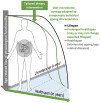Regional Diets Targeting Gut Microbial Dynamics to Support Prolonged Healthspan
- PMID: 33995322
- PMCID: PMC8116520
- DOI: 10.3389/fmicb.2021.659465
Regional Diets Targeting Gut Microbial Dynamics to Support Prolonged Healthspan
Abstract
In the last 150 years, we have seen a significant increase in average life expectancy, associated with a shift from infectious to non-communicable diseases. The rising incidence of these diseases, for which age is often the largest risk factor, highlights the need for contemporary societies to improve healthy ageing for their growing silver generations. As ageing is an inevitable, non-reversing and highly individualised process, we need to better understand how non-genetic factors like diet choices and commensal gut microbes can modulate the biology of ageing. In this review, we discuss how geographical and ethnic variations influence habitual dietary patterns, nutrient structure, and gut microbial profiles with potential impact on the human healthspan. Several gut microbial genera have been associated with healthy elderly populations but are highly variable across populations. It seems unlikely that a universal pro-longevity gut microbiome exists. Rather, the optimal microbiome appears to be conditional on the microbial functionality acting on regional- and ethnicity-specific trends driven by cultural food context. We also highlight dietary and microbial factors that have been observed to elicit individual and clustered biological responses. Finally, we identify next generation avenues to modify otherwise fixed host functions and the individual ageing trajectory by manipulating the malleable gut microbiome with regionally adapted, personalised food intervention regimens targeted at prolonging human healthspan.
Keywords: bioactive compounds; gut microbiome; gut microbiota; healthy ageing; personalised diet; phytonutrients; prolonged healthspan.
Copyright © 2021 Low, Hejndorf, Tharmabalan, Poppema and Pettersson.
Conflict of interest statement
The authors declare that the research was conducted in the absence of any commercial or financial relationships that could be construed as a potential conflict of interest.
Figures





Similar articles
-
Adjusting for age improves identification of gut microbiome alterations in multiple diseases.Elife. 2020 Mar 11;9:e50240. doi: 10.7554/eLife.50240. Elife. 2020. PMID: 32159510 Free PMC article.
-
The role of the gut microbiome during host ageing.F1000Res. 2018 Jul 16;7:F1000 Faculty Rev-1086. doi: 10.12688/f1000research.15121.1. eCollection 2018. F1000Res. 2018. PMID: 30057748 Free PMC article. Review.
-
The East Asian gut microbiome is distinct from colocalized White subjects and connected to metabolic health.Elife. 2021 Oct 7;10:e70349. doi: 10.7554/eLife.70349. Elife. 2021. PMID: 34617511 Free PMC article.
-
The gut microbiota of centenarians: Signatures of longevity in the gut microbiota profile.Mech Ageing Dev. 2017 Jul;165(Pt B):180-184. doi: 10.1016/j.mad.2016.12.013. Epub 2016 Dec 31. Mech Ageing Dev. 2017. PMID: 28049008 Review.
-
Ageing of the gut microbiome: Potential influences on immune senescence and inflammageing.Ageing Res Rev. 2021 Jul;68:101323. doi: 10.1016/j.arr.2021.101323. Epub 2021 Mar 23. Ageing Res Rev. 2021. PMID: 33771720 Review.
Cited by
-
Nutritional and lifestyle management of the aging journey: A narrative review.Front Nutr. 2023 Jan 24;9:1087505. doi: 10.3389/fnut.2022.1087505. eCollection 2022. Front Nutr. 2023. PMID: 36761987 Free PMC article. Review.
-
Utilization of Host and Microbiome Features in Determination of Biological Aging.Microorganisms. 2022 Mar 21;10(3):668. doi: 10.3390/microorganisms10030668. Microorganisms. 2022. PMID: 35336242 Free PMC article. Review.
-
Got the Munchies for an Egg Sandwich? The Effects of Cannabis on Bowel Motility and Beyond.J Nucl Med Technol. 2024 Mar 5;52(1):8-14. doi: 10.2967/jnmt.123.266816. J Nucl Med Technol. 2024. PMID: 38443102 Free PMC article.
References
-
- Barabási A.-L., Menichetti G., Loscalzo J. (2020). The unmapped chemical complexity of our diet. Nat. Food 1 33–37. 10.1038/s43016-019-0005-1 - DOI
-
- Berendsen A. A. M., van de Rest O., Feskens E. J. M., Santoro A., Ostan R., Pietruszka B., et al. (2018). Changes in dietary intake and adherence to the NU-AGE diet following a one-year dietary intervention among European older adults- Results of the NU-AGE randomized trial. Nutrients 10:1905. 10.3390/nu10121905 - DOI - PMC - PubMed
Publication types
LinkOut - more resources
Full Text Sources
Other Literature Sources
Research Materials

